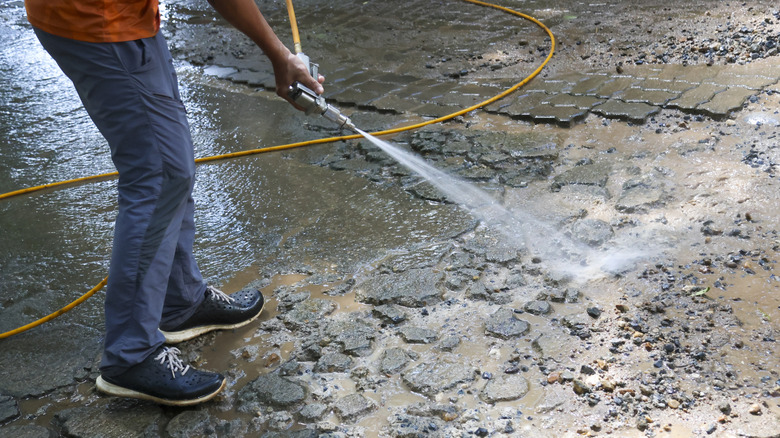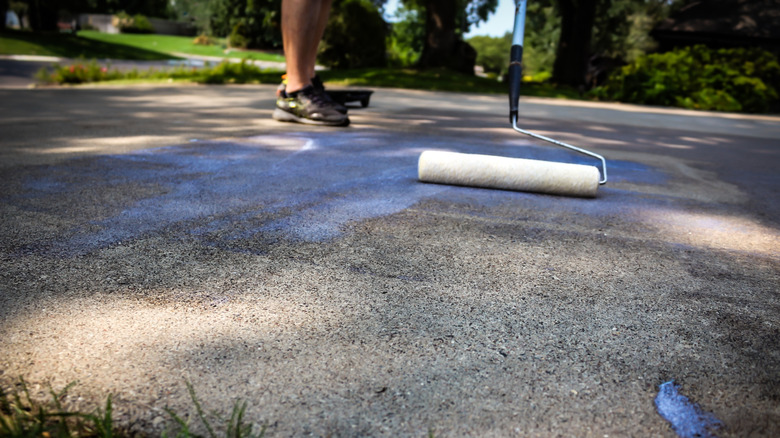Why Your Concrete Driveway Is Flaking And How To Fix It
Seeing the surface of your concrete driveway start to chip or peel away is frustrating, especially when you consider they're supposed to last decades. Why is your concrete driveway flaking, and what can you do about it? The main causes of spalling, as it's officially called, are moisture and freeze-thaw cycles. When water soaks into the concrete and the temperature drops below freezing, the water expands. The top layer of the concrete driveway cracks and flakes due to the internal pressure created, resulting in the flakes and pits you see. Repeated freezing and thawing over the winter months will continue this process. The solution involves patching the damaged areas with a concrete resurfacer and then sealing the entire surface to prevent water absorption.
While salt and de-icing chemicals are useful for melting ice, they can make spalling worse. These chemicals work by lowering the freezing point of water, subjecting the concrete to more frequent freeze-thaw cycles and increased damage. Another common issue is the concrete driveway finishing process. Applying a finish in the presence of water or adding water to the mix to make it easier to work with creates a thin, weak top layer of concrete. This layer is more likely to flake when exposed to cold weather and chemicals. There are must-do tasks to prepare your concrete driveway for winter, but they can only do so much.
Steps you can take to prepare flaking concrete for treatment
Spalling is irreversible and the ruined concrete will eventually need to be replaced. In the meantime, you can repair your driveway using cosmetic patches, which look good and slow down the damage. Before you can apply a patch, you need to prepare the affected area. The first step is to clean the surface to remove all the loose, flaking, or otherwise damaged concrete, as well as any dirt, grease, oil, or previous finishes and sealers.
You can use a stiff-bristle or wire brush, or a pressure washer, to get rid of the loose material. For stubborn flakes, you might need to use a chipping hammer or a grinder. The goal is to get down to a solid layer. If there's any loose material, the patch won't bond to the driveway, resulting in more flaking. Treat tough grease or oil stains with a concrete degreaser and a scrubbing brush and then rinse with clean water.
Once the driveway is clean and dry, you can choose to apply a bonding agent to the area you're patching. This liquid product helps the older concrete accept the new material. It's an additional but recommended step. After all that cleaning work, it's not worth skipping. It could be the curb appeal mistake that hurts your chances of selling your home in the future. If you prefer to proceed with patching, work quickly or lightly mist the surface with a garden hose. Patching products adhere better to concrete that is slightly damp. Make sure, too, that the temperature won't drop below 50 degrees Fahrenheit for at least a few days.
How do you prevent further damage to a flaking concrete driveway?
With the surface of your concrete driveway prepped, you can now begin patching and sealing the affected area. Patching materials are usually cement-based products with polymers added to increase strength and bonding. Mix the repair compound according to the manufacturer's instructions, taking care not to add too much water, which could weaken the material and even lead to future spalling. Apply the mixed repair compound to the dampened area using a trowel. Work it into the surface until it's level with the surrounding intact driveway. Allow the material to cure, which can take several days, depending on the product and the weather. After the material has cured, apply a high-quality concrete sealer.
Do you really need to seal your driveway? A good sealer penetrates the concrete and creates a protective barrier that prevents water and de-icing chemicals from soaking into the surface. This reduces the effects of the freeze-thaw cycle, which is the primary cause of flaking or spalling. You can choose between a penetrating sealer, which chemically reacts with the concrete, or an acrylic sealer, which creates a protective film on top of the concrete. Reapplying the sealer periodically — every two to 10 years, depending on use and climate — can help you prolong the life of your driveway. However, while the patch repair combined with the sealer will buy you some time, the only long-term solution to spalling is replacing the entire concrete driveway.


